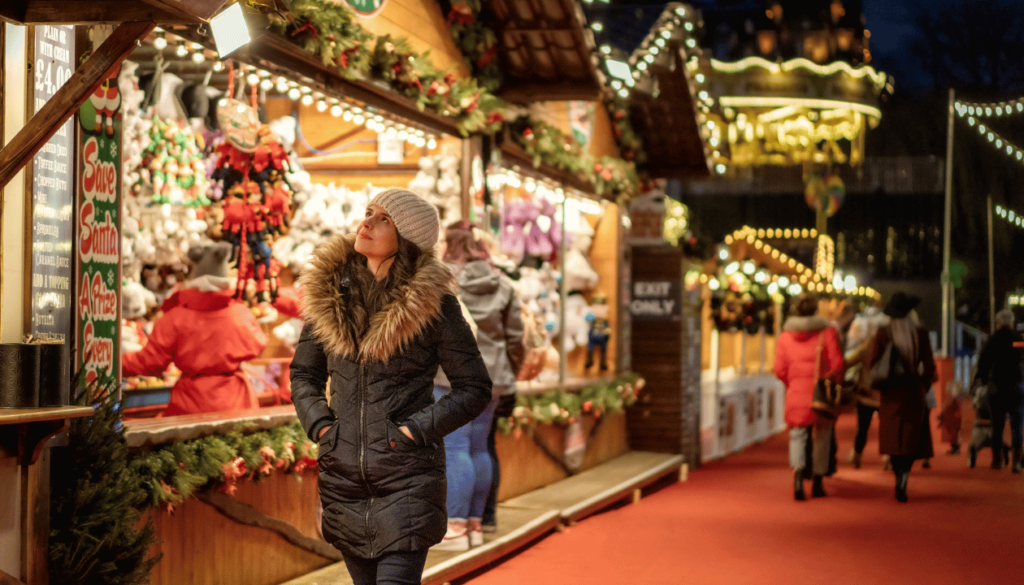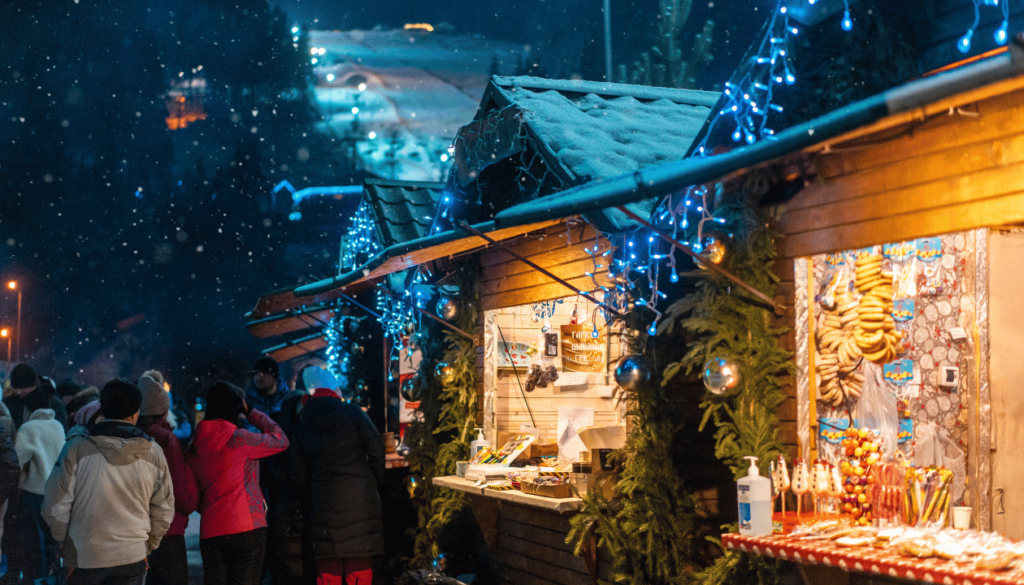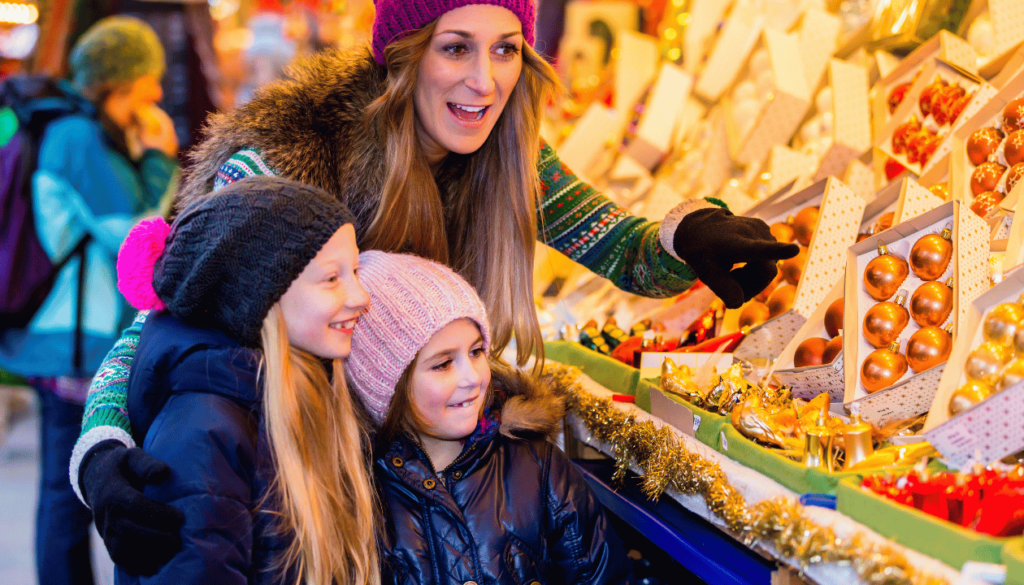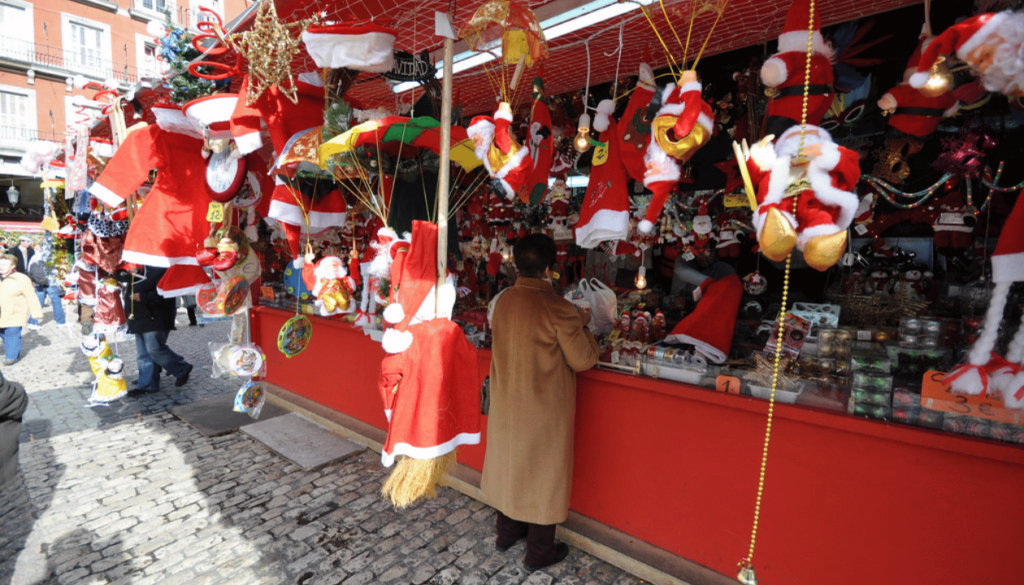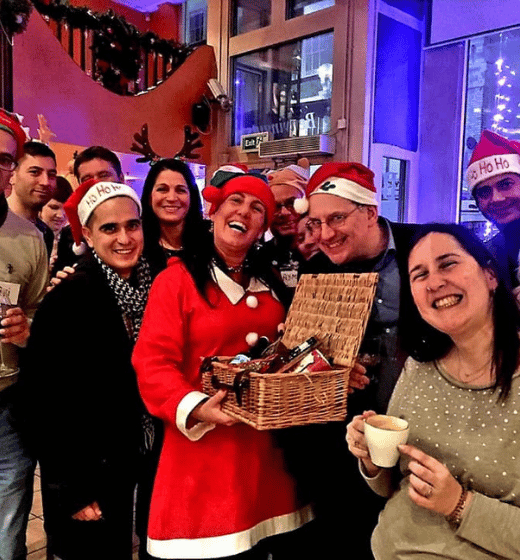

Christmas in Spain is a time of joy, tradition, and festivity that stretches well beyond the 25th of December.
The country’s rich cultural heritage is reflected in its vibrant Christmas markets, or mercadillos de Navidad, where visitors can experience a magical blend of history, local crafts, delicious seasonal treats, and festive spirit.
Each region of Spain celebrates Christmas in its unique way, from bustling urban centers to picturesque coastal towns.
Let’s explore some of Spain’s most enchanting Christmas markets, offering a glimpse into the country’s deep-rooted traditions and and Christmas festivities.
The Origins of Christmas Markets in Spain
While Spain is renowned for its festive traditions, the concept of Christmas markets originally came from central Europe, particularly Germany and Austria, where markets date back to the Middle Ages.
However, Spain quickly embraced the custom, infusing it with its own cultural elements. Now, these markets serve as hubs for local artisans, food vendors, and holiday festivities, providing a perfect setting to celebrate the season.
From the famous Barcelona Christmas Market, Fira de Santa Llúcia, to the charming Granada Christmas Market, Spain’s Christmas markets have become a highlight of the holiday season.
Christmas Traditions Unique to Spain
Christmas in Spain is more than just markets and decorations. The holiday season stretches across several weeks, and each region has its own customs and traditions.
A key difference between Spanish Christmas and that of other countries is the importance of Los Reyes Magos (The Three Kings) on January 6th. In many parts of Spain, this day is when children receive their gifts, and it’s often celebrated with grand parades known as cabalgatas.
Another notable tradition is the singing of villancicos (Spanish Christmas carols). These songs are rooted in both religious and cultural history, often incorporating flamenco influences in regions like Andalucía.
Families also take time to visit elaborate Nativity scenes (belenes) displayed in homes and public spaces across the country.
Seasonal Spanish Delicacies to Try at Christmas Markets
One of the highlights of visiting Spain during the Christmas season is the chance to indulge in traditional holiday foods. Each region has its specialties, but certain dishes and sweets, often associated with Hispanic Christmas food, are found at nearly every Christmas market. Here are some delicacies you shouldn’t miss:

- Turrón: This nougat made of almonds, honey, and sugar is a Christmas staple in Spain. It comes in a variety of textures and flavors, with the most famous varieties hailing from Alicante.
- Polvorones and Mantecados: These crumbly shortbread-like cookies are flavored with almonds and often wrapped in festive packaging. They are a must-have treat during the holidays.
- Churros and Chocolate: Many markets feature stalls serving churros, fried dough pastries, accompanied by thick, rich hot chocolate—a perfect combination for chilly winter evenings.
- Roscón de Reyes: Eaten on January 6th to celebrate Three Kings Day, this round cake is decorated with candied fruits and often contains a small hidden surprise—usually a figurine of a king and a dry bean.
Christmas Lights and Decorations in Spain
Spain’s Christmas markets are often set against a backdrop of breathtaking light displays and festive decorations. Cities like Madrid and Barcelona go all out during the holiday season, with entire streets and plazas illuminated by dazzling lights.
- Barcelona: The entire city is bathed in festive lights, with key spots like Passeig de Gràcia and the Gothic Quarter offering some of the best displays.
- Madrid: The capital is famous for its elaborate light installations that stretch across Gran Vía, Puerta del Sol, and Calle de Alcalá. Madrid also features a massive Christmas tree in Plaza Mayor, making the area even more magical at night.
- Málaga: Perhaps the most famous for Christmas lights in southern Spain, Málaga’s Calle Larios is transformed into a light spectacle each year, drawing thousands of visitors.
Sustainability at Christmas Markets in Spain
Many of Spain’s Christmas markets are adopting more sustainable practices to reduce their environmental impact. As awareness of sustainability grows, market organizers are taking steps to offer eco-friendly alternatives:
- Plastic-Free Stalls: Some markets, especially in larger cities like Barcelona and Madrid, are encouraging vendors to use biodegradable packaging and limit single-use plastics.
- Local and Ethical Goods: Many markets promote locally produced, handmade goods that support local artisans and reduce the carbon footprint of importing goods from abroad.
- Energy-Efficient Lights: Christmas lights are a big part of Spain’s festive charm, and many cities are transitioning to LED lighting and energy-efficient systems to make their displays more sustainable.
Family-Friendly Activities at Christmas Markets
Spain’s Christmas markets offer much more than just shopping and eating. Many markets, especially in larger cities, feature activities for the whole family. These markets often host ice-skating rinks, carousels, and entertainment designed to engage visitors of all ages. Popular family-friendly activities include:
- Ice Skating: Many markets, like those in Madrid and Seville, feature temporary ice rinks where families can enjoy skating together.
- Nativity Scenes: Visiting the life-sized belenes in public squares, like those in Valencia and Girona, is a popular family activity. These displays are often accompanied by performances that tell the Nativity story.
- Craft Workshops for Kids: Markets in Barcelona, Cádiz, and other cities often have areas dedicated to children where they can participate in craft-making workshops or festive games.
Tips for Visiting Spain’s Christmas Markets
To fully enjoy your Christmas market experience in Spain, it’s essential to plan ahead. Here are some helpful tips to make your visit as festive and smooth as possible:
- Timing Your Visit: While weekends are lively, they can also be crowded, especially in major cities like Madrid and Barcelona. If you prefer a quieter experience, visit on a weekday evening when the markets are still vibrant but less crowded.
- Dress Warmly: Although Spain is known for its mild weather, winter nights can be chilly, especially in northern regions like Burgos and Madrid. Layer up to stay comfortable while browsing the stalls and enjoying outdoor festivities.
- Carry Cash: While many vendors accept cards, it’s a good idea to carry some cash, especially in smaller markets or for small purchases like food and souvenirs.
- Sampling the Food: Don’t miss out on tasting regional Christmas foods at each market. Make sure to try local delicacies specific to each region—whether it’s ensaimadas in Menorca or pestiños in Cádiz.
And now let’s have a look some of the best Christmas markets in Spain:
1. Fira de Santa Llúcia – Barcelona
Dates: Late November to December 23rd
Location: Cathedral Square, Gothic Quarter
Barcelona’s Fira de Santa Llúcia is the city’s most iconic Christmas market, held annually since 1786. Situated in the shadow of the stunning Barcelona Cathedral, this market is steeped in tradition and offers a rich display of local crafts, Christmas decorations, and seasonal treats.
Visitors are greeted by a sea of over 280 stalls selling everything from handcrafted jewelry to intricate Nativity scene figures known as belénes. The market is also home to unique Catalan traditions, such as the Caga Tió—a smiling log that children “feed” during December and then “beat” with sticks on Christmas Eve to receive gifts.
What to Buy:
- Traditional Catalan Figures: Look for Caga Tió and caganers, small figurines humorously hidden in Nativity scenes.
- Handmade Gifts: Jewelry, ceramics, and wooden toys make for perfect presents.
- Christmas Trees and Plants: There’s a dedicated section for purchasing Christmas trees and festive greenery.
Experience Tip: The Fira offers special children’s activities, making it a family-friendly destination. Visit in the evening to see the Gothic Quarter beautifully illuminated with Christmas lights.
2. Mercado de Navidad – Valencia
Dates: Early December to January 6th
Location: Plaza del Ayuntamiento and Mercado de Colón
Valencia’s Christmas market is a beautiful blend of local tradition and holiday charm. The stalls around Plaza del Ayuntamiento are filled with holiday decorations, handmade crafts, and local delicacies. The nearby Mercado de Colón, a stunning modernist building, complements the festive atmosphere with artisan food stalls, live performances, and seasonal activities.
In Valencia, Christmas is all about family and food, so expect to find stalls selling traditional sweets like turrón and polvorones. The market also features a large belén display, showcasing the intricate craftsmanship of the local artisans.
What to Buy:
- Valencian Ceramics: Renowned for their intricate designs, ceramic pieces make for wonderful gifts.
- Gourmet Treats: Be sure to sample buñuelos (fried dough balls) and local wines.
- Artisan Leather Goods: Valencia is known for its high-quality leather products, perfect for a personalized Christmas gift.
Experience Tip: Don’t miss the light displays around the town hall, which illuminate the city’s historic center with festive colors. The Mercado de Colón also hosts a children’s ice-skating rink, adding to the festive fun.
3. Mercat de Nadal – Maó, Menorca
Dates: Early December to January 6th
Location: Plaza Constitución, Maó
Menorca, known for its tranquility and natural beauty, brings a cozy, intimate atmosphere to its Christmas market in the island’s capital, Maó. This market may be smaller than those in larger cities, but it’s packed with local charm.
The stalls feature local Menorcan crafts, including handmade ceramics and jewelry, as well as an array of delicious island delicacies like ensaimadas—fluffy pastries perfect for a Christmas breakfast.
What to Buy:
- Menorcan Cheeses: Menorca is famous for its artisanal cheeses, a great gift for food lovers.
- Handmade Textiles: Find unique scarves, shawls, and blankets crafted from local materials.
- Traditional Pastries: Don’t leave without trying ensaimadas, a beloved Menorcan treat.
Experience Tip: Visit on weekends for live music performances and carol singing that add a festive vibe to this charming market.
4. Mercat de Nadal – Palma, Mallorca
Dates: Early December to January 6th
Location: Plaza Mayor, Palma de Mallorca
Palma de Mallorca’s Christmas market in Plaza Mayor is a bustling hub of holiday activity. With the entire historic center lit up by Christmas lights, the market creates a magical setting for visitors to enjoy the season.
You’ll find an abundance of artisan crafts, including Mallorcan ceramics, leather goods, and glassware from the island’s famous factories.
What to Buy:
- Mallorcan Glassware: Hand-blown glass items are a specialty of the island.
- Leather Goods: Mallorca is famous for its high-quality leather, especially bags and shoes.
- Traditional Christmas Sweets: Sample turrón, polvorones, and the island’s specialty, neules (wafers).
Experience Tip: Explore the smaller markets that pop up around the city, including those near La Seu Cathedral, offering stunning views over the bay.
5. Mercado Navideño – Burgos
Dates: Early December to January 6th
Location: Plaza Mayor, Burgos
In the historic city of Burgos, the Christmas market in Plaza Mayor offers visitors a taste of traditional Castilian Christmas charm. The market is known for its handmade crafts, particularly woolen goods and ceramics, as well as the region’s famous morcilla (blood sausage). Burgos is a city steeped in history, and the festive lights and decorations create a picturesque holiday scene.
What to Buy:
- Handwoven Woolen Goods: Pick up cozy scarves, hats, and blankets to keep warm during the winter.
- Morcilla de Burgos: This local delicacy makes for a unique edible gift.
- Traditional Pottery: Burgos is known for its artisanal ceramics, perfect for decorating your home.
Experience Tip: Visit the nearby Burgos Cathedral, a UNESCO World Heritage Site, which is beautifully lit during the Christmas season.
6. Mercado Navideño – Sevilla
Dates: Early December to January 5th
Location: Plaza Nueva, Sevilla
Seville’s Christmas market exudes Andalusian charm, with flamenco performances, horse-drawn carriages, and stalls showcasing the region’s renowned crafts. Set in Plaza Nueva, the market is filled with handmade leather goods, ceramics, and festive decor. The Andalusian flair is also evident in the market’s food stalls, where visitors can enjoy traditional sweets like pestiños and polvorones.
What to Buy:
- Flamenco-Inspired Gifts: From clothing to accessories, Seville’s market offers flamenco-themed items that reflect the region’s cultural heritage.
- Artisan Leather Goods: Pick up handcrafted belts, bags, and shoes made by local artisans.
- Andalusian Sweets: Indulge in pestiños (fried dough with honey) and mantecados (shortbread).
Experience Tip: Take a carriage ride around the city to experience Seville’s Christmas lights and historic streets from a new perspective.
7. Mercado de Navidad – Cádiz
Dates: Early December to January 6th
Location: Plaza de San Antonio, Cádiz
Cádiz’s Christmas market offers a laid-back, coastal vibe, with its stalls lining Plaza de San Antonio. Known for its traditional Andalusian crafts and local delicacies, this market is a wonderful place to pick up unique gifts. Cádiz’s picturesque streets and warm coastal weather make it an ideal destination for those seeking a different kind of Christmas atmosphere.
What to Buy:
- Handmade Ceramics and Jewelry: Cádiz is known for its beautiful artisanal goods.
- Local Sweets: Try alfajores and roscos de vino, traditional holiday treats.
- Leather Goods: High-quality handcrafted leather items are a must-buy in this region.
Experience Tip: Don’t miss the Christmas concerts and performances held in the market square throughout December.
8. Plaza Mayor Christmas Market – Madrid
Dates: Late November to December 31st
Location: Plaza Mayor, Madrid
The Plaza Mayor Christmas market is Madrid’s most famous festive destination. It transforms the city’s grand square into a bustling marketplace, with over 100 stalls selling Christmas decorations, belén figures, and artisan crafts. Madrid’s market is particularly known for its extensive selection of miniature figures for Nativity scenes, making it a great place to start or add to your collection.
What to Buy:
- Nativity Figures: Madrid is home to some of the best belén artisans in Spain.
- Christmas Ornaments: Pick up unique decorations for your tree or home.
- Artisan Sweets: Sample traditional turrón and mazapán (marzipan) made by local vendors.
Experience Tip: The market is best visited in the evening when the entire Plaza Mayor is illuminated with festive lights.
9. Mercado de Navidad – Girona
Dates: Early December to January 6th
Location: Plaça Independència, Girona
Girona’s Christmas market, set in the charming Plaça Independència, is known for its cozy, intimate atmosphere. The stalls offer a mix of Catalan crafts, holiday decor, and local foods. The city’s medieval architecture and winding streets make it a beautiful setting for a festive outing.
What to Buy:
- Catalan Crafts: Handcrafted textiles, ceramics, and jewelry.
- Local Sweets: Sample turrón and neules (rolled wafers), Catalan Christmas specialties.
- Artisan Gifts: Pick up handmade decorations and holiday gifts from local artisans.
Experience Tip: Visit the Christmas lights display that illuminates Girona’s historic center for a magical holiday experience.
10. Mercado de Navidad – Murcia
Dates: Early December to January 5th
Location: Plaza de Santo Domingo, Murcia
Murcia’s Christmas market offers a blend of traditional Murcian crafts and local delicacies. Set in Plaza de Santo Domingo, the market features stalls selling handmade pottery, wooden toys, and Christmas decorations. Murcia’s warm weather makes it a pleasant destination for a festive stroll through the market, while enjoying the local holiday spirit.
What to Buy:
- Murcian Pottery: Known for its bold designs, Murcian ceramics make for great gifts.
- Local Foods: Try paparajotes (fried lemon leaves) and turrón for a taste of the region’s specialties.
- Christmas Ornaments: Handmade decorations from Murcia’s artisans add a unique touch to your home.
Experience Tip: Be sure to check out the life-sized belén in Plaza Santo Domingo, which attracts visitors from all over the region.
Wrapping Up the Magic: Your Ultimate Christmas Adventure in Spain
Spain’s Christmas markets are more than just places to shop; they are gateways to the country’s deep-rooted holiday traditions, cultural pride, and festive spirit.
Each market, from the bustling streets of Madrid to the tranquil plazas of Menorca, invites you to explore local craftsmanship, savor seasonal delicacies, and witness the charm of a Spanish Christmas.
Whether you’re wandering through the illuminated Gothic Quarter in Barcelona or marveling at life-sized belenes in Seville, these markets encapsulate the warmth and magic of the holiday season.
As you journey through Spain’s vibrant Christmas markets, you’ll discover that the spirit of Christmas here goes far beyond decorations and gifts. It’s about community, history, and the joy of coming together to celebrate in the most enchanting settings.
Whether you’re seeking the perfect handmade gift, enjoying a cup of hot chocolate by the lights, or simply soaking up the festive atmosphere, Spain’s Christmas markets offer a truly unforgettable holiday experience.
If you fancy experiencing the magic of Spanish markets with us, make sure you join our Spanish Homestay Immersion Program (SHIP), where you can not only enjoy the festivities but also immerse yourself in the language and culture, all while living and learning with a local teacher.
¡FELIZ NAVIDAD!
Cultural Quiz: Spanish Christmas Traditions
1. Which day do Spaniards traditionally receive their Christmas gifts?
A) December 24th
B) December 25th
C) January 1st
D) January 6th
2. What is the traditional sweet eaten during the Three Kings Day celebrations?
A) Churros
B) Polvorones
C) Roscón de Reyes
D) Tarta de Santiago
3. In Spain, which Christmas market is known for its Catalan traditions like Caga Tió and caganers?
A) Plaza Mayor Christmas Market, Madrid
B) Mercado de Navidad, Valencia
C) Fira de Santa Llúcia, Barcelona
D) Mercado Navideño, Sevilla
4. What is turrón, a popular Spanish Christmas treat, primarily made from?
A) Honey and almonds
B) Chocolate and nuts
C) Sugar and cinnamon
D) Rice and milk
5. Which city is famous for its extravagant Christmas light displays on Calle Larios?
A) Madrid
B) Málaga
C) Seville
D) Girona
6. What is the name of the Spanish Christmas carols commonly sung during the festive season?
A) Fandangos
B) Flamencos
C) Villancicos
D) Coplas
7. Which food item is traditionally fried and served with hot chocolate at Spanish Christmas markets?
A) Empanadas
B) Churros
C) Paella
D) Croquetas
8. In which city is the famous Plaza Mayor Christmas market held?
A) Madrid
B) Valencia
C) Burgos
D) Cádiz
9. Which of the following sweets is typically associated with Andalusian Christmas markets?
A) Alfajores
B) Ensaimadas
C) Tarta de Santiago
D) Roscón de Reyes
10. What traditional Spanish Christmas figure is often hidden in Nativity scenes as a humorous touch?
A) The Shepherd
B) The Three Kings
C) The Wise Man
D) The Caganer
Culture Quiz: Key Answers
1. Which day do Spaniards traditionally receive their Christmas gifts?
Answer: D) January 6th
(Explanation: Gifts are typically given on Three Kings’ Day, known as Día de los Reyes Magos).
2. What is the traditional sweet eaten during the Three Kings Day celebrations?
Answer: C) Roscón de Reyes
(Explanation: This round cake is eaten on January 6th and often contains small surprises inside).
3. In Spain, which Christmas market is known for its Catalan traditions like Caga Tió and caganers?
Answer: C) Fira de Santa Llúcia, Barcelona
(Explanation: Barcelona’s market is famous for these unique Catalan traditions).
4. What is turrón, a popular Spanish Christmas treat, primarily made from?
Answer: A) Honey and almonds
(Explanation: Turrón is a nougat made from honey, almonds, and sugar, popular during Christmas).
5. Which city is famous for its extravagant Christmas light displays on Calle Larios?
Answer: B) Málaga
(Explanation: Málaga’s Christmas lights on Calle Larios are renowned across Spain).
6. What is the name of the Spanish Christmas carols commonly sung during the festive season?
Answer: C) Villancicos
(Explanation: Villancicos are traditional Spanish Christmas carols).
7. Which food item is traditionally fried and served with hot chocolate at Spanish Christmas markets?
Answer: B) Churros
(Explanation: Churros are fried dough pastries typically served with hot chocolate).
8. In which city is the famous Plaza Mayor Christmas market held?
Answer: A) Madrid
(Explanation: Madrid’s Plaza Mayor hosts one of Spain’s most iconic Christmas markets).
9. Which of the following sweets is typically associated with Andalusian Christmas markets?
Answer: A) Alfajores
(Explanation: Alfajores, often made with almonds, are popular Christmas treats in Andalusia).
10. What traditional Spanish Christmas figure is often hidden in Nativity scenes as a humorous touch?
Answer: D) The Caganer
(Explanation: The caganer is a small figure humorously hidden in Catalan Nativity scenes).


